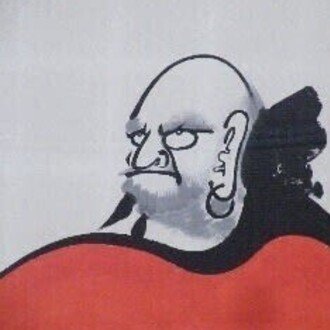
白隠慧鶴の「隻手音声」で本来の自己を究明 【禅問答シリーズ2】 Investigate the original self with Hakuin Ekaku's "The Sound of One Hand" [Zen Question and Answer Series 2]
昨日、図書館で日本画の美術全集をめくっていると白隠慧鶴(はくいんえかく/1686~1769)の「達磨像」が目に入った。独特のタッチの絵を描く画僧であり禅師である。禅の代表的な公案(禅問答)を創始した人で、臨済宗の中興の祖といわれている。
Yesterday, when I was flipping through the complete collection of Japanese paintings at the library, I saw the "Daruma statue" of Hakuin Ekaku (1686-1769). He is a painter and Zen master who draws pictures with a unique touch. He is the founder of Zen's representative koan (Zen question and answer), and is said to be the founder of the Rinzai sect.
その白隠禅師が創始した公案の一則である「隻手音声(せきしゅのおんじょう)」を以前も紹介したが、印象深い禅問答なので今回も解る範囲内ではあるが紐解いてみる。
日常で使う禅問答は会話がかみ合わない様子のことをいうが、本来の禅問答は禅宗の僧による言葉や動作のやり取りのこという。修行者が疑問を投げかけ、それに対して指導者が答える一連を問答のことをいう。
I have introduced "The Sound of One Hand", which is a rule of the Koan founded by Hakuin Ekaku, but since it is an impressive Zen question and answer, I will try to unravel it this time as well.
Zen questions and answers used in daily life refer to the appearance of conversations not engaging, but the original Zen questions and answers refer to the exchange of words and actions by Zen Buddhist monks. A series of questions and answers that the practitioner asks a question and the instructor answers to it.
禅問答は、もともと中国の禅僧「雪竇重顕(せっちょうじゅうけん)」によってまとめられた『雪竇頌古(せっちょうじゅこ)』と呼ばれる初の公案集。これに、同じく中国の禅僧「圜悟克勤(えんごこくごん)」によって手が加えられた『碧巌録(へきがんろく)』として現在でも有名な公案集となっている。
まず碧巌録という難しい字に興味を持った。かなり前だが、京都・相国寺に参拝した折に山内にある大通院(相国寺塔頭)の扁額(写真)に「碧巌録提唱」と篆書体のような文字で書かれていた。それが相国寺の修行の専門道場だった。それを見たことで碧巌録への関心がさらに強くなった。
The Zen question and answer is the first collection of koan called "Xuedou Chongx", which was originally compiled by the Chinese Zen priest "Xuedou Chongxian". In addition to this, it is still a famous collection of public proposals as "Hekiganroku", which was also modified by the Chinese Zen priest "Yuanwu Keqin".
I was interested in the difficult character called Hekiganroku. A long time ago, when I visited Shokoku-ji Temple in Kyoto, it was written in a seal script-like character on the flat frame (photo) of Daitsū-in Temple (Shokoku-ji Temple) in Yamauchi. That was the specialized dojo for training at Shokokuji Temple. Seeing that made me even more interested in Hekiganroku.

さて、私の印象に強く残っている問答の一つに「隻手音声(せきしゅのおんじょう)」がある。「隻手(せきしゅ/片手)になんの声やある。隻手の声を拈提(ねんてい)せよ」という白隠禅師が創始した問答。(「両手を打ち合わせると音がするが、片手にはどんな音がするか。それを報告しなさい」という意味)
By the way, one of the questions and answers that left a strong impression on me was "The Sound of One Hand". The question and answer founded by Hakuin Ekaku, "What is the voice of the sound of one hand? Let's make the voice of the sound of one hand."(It means, "When you hit both hands, it makes a sound, but what kind of sound does one hand make? Report it.")
3年前に佐川美術館(滋賀)で「白隠と仙厓展」を鑑賞したとき、白隠と仙厓のユーモラスで軽妙、かつ大胆な書画に改めて驚かされた。画自体はもちろんだが、禅の意味を画と賛で重層的に表現する禅画には禅問答が示されていて、どこかにヒントが隠されているものの答えは見えない。それは、見た人に考えさせ、みずからの答えを導き出させるためのものある。白隠の禅画に表されているのは、人としての本質を問うものばかりで、探れば探るほど奥深い。浅見識ではあるが、白隠慧鶴の禅僧としての神髄の一旦を楽しむことができた。
When I watched the "Hakuin and Sengai Exhibition" at the Sagawa Art Museum (Shiga) three years ago, I was once again surprised by the humorous, light and bold calligraphy of Hakuin and Sengai. Not to mention the painting itself, Zenga, which expresses the meaning of Zen in layers with paintings and praises, shows Zen questions and answers, and although hints are hidden somewhere, the answers cannot be seen.It is meant to make the viewer think and come up with his own answer. Hakuin's Zen paintings only question the essence of human beings, and the more you explore, the deeper you are. Although it is a shallow insight, I was able to enjoy the essence of Hakuin Ekaku as a Zen priest.

その禅問答を一画で紹介すると、江戸時代に画かれた「隻手布袋図」(写真)は「隻手音声」の禅問答そのものである。「両手を叩けば音がするが、隻手ではどんな音がするか聞いて来い」という、白隠の代表的な公案画。その心は、常識や当然にこだわり、それが正しいと凝り固まっていてはいけないという、まさに禅問答の典型のようなものである。
Introducing the Zen question and answer in one stroke, the "The Sound of One Hand Budai Figure" (photo) drawn in the Edo period is the Zen question and answer of "The Sound of One Hand". Hakuin's representative koan picture, "If you hit both hands, you will hear a sound, but please ask what kind of sound it makes with the sound of one hand." That mind is just like a typical Zen question and answer that you should stick to common sense and of course, and not be entrenched if it is correct.

禅問答集を参照しながら、上記の禅問答を少し解説すると、我々は「物」をみるのは「眼」で、「音」を聞くのは「耳」で、と思い込んでいる。この思い込みが「妄想」だという。この常識や分別を外せば、片手でも音は聞こえるという。
To explain the above Zen questions and answers a little while referring to the Zen questions and answers, we assume that "things" are seen by "eyes" and "sounds" are heard by "ears". This belief is said to be a "delusion." If this common sense and sensibleness are removed, the sound can be heard with one hand.
般若心経にあるように、不生不滅。不垢不浄。不増不減。無限耳鼻舌身意。の意味のとおり一切の対立観念の無い完全無分別の世界、ということになる。自己と対象が一体とならなければ妙音は出ない。「片手の音」とは、まだ自己と対象が一体になってない状態で自己を見失ったままの状態。思慮分別を捨て、“本来の自己”を究明することから禅の修業が始まる。
As in the Heart Sutra, it is immortal. Innocent and unclean. No increase or decrease. Infinite ear, nose, tongue and body. As the meaning of, it is a completely ill-advised world without any confrontation.If the self and the object are not united, there will be no strange sound. "One-handed sound" is a state in which the self and the object are not yet united and the self is lost. Zen training begins by abandoning discretion and investigating the "original self."

リポート&写真/ 渡邉雄二 写真資料/ 日本画大全集・白隠と仙厓展チラシより Reported & Photos by Yuji Watanabe
いいなと思ったら応援しよう!

